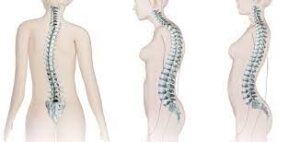Introduction
Spinal deformity refers to abnormal curvatures or misalignments of the spine, such as scoliosis, kyphosis, or lordosis. These conditions can be present at birth (congenital) or develop later in life due to various factors. Spinal deformities can cause discomfort, affect posture, and impact overall mobility and quality of life.

Symptoms
The symptoms of spinal deformity can vary depending on the type and severity of the condition. Common symptoms may include:
Abnormal curvature of the spine: This may manifest as sideways curvature (scoliosis), excessive forward curvature (kyphosis), or excessive backward curvature (lordosis).
Visible changes in posture: Uneven shoulder or hip levels, protruding shoulder blades, or a hunched appearance.
Back pain or discomfort: This can range from mild to severe and may be present during activities or even at rest.
Restricted mobility: Spinal deformities can limit the range of motion and flexibility of the spine, leading to difficulties in performing certain movements or activities.
Diagnosis
Diagnosing a spinal deformity involves a thorough evaluation by healthcare professionals, often including orthopedic specialists or spine surgeons. Diagnostic procedures may include:
Physical examination: The healthcare provider will assess the spine’s curvature, observe the individual’s posture, and check for any signs of abnormal alignment or asymmetry.
Imaging tests: X-rays, MRI scans, or CT scans may be ordered to obtain detailed images of the spine, allowing for accurate measurement of the curvature and assessment of any underlying structural abnormalities.
Treatment
The treatment for spinal deformity depends on several factors, including the type, severity, and progression of the condition, as well as the individual’s age and overall health. Treatment options may include:
Observation: In mild cases of spinal deformity that are not progressive and do not cause significant symptoms, regular monitoring may be recommended.
Bracing: For moderate spinal deformities, especially in growing children and adolescents, bracing may be prescribed. The brace helps slow down or prevent further progression of the curvature by providing external support to the spine.
Physical Therapy and Exercises: Specific exercises and physical therapy techniques can help improve posture, strengthen core muscles, and increase flexibility. These exercises are often tailored to the individual’s specific spinal deformity and overall condition.
Surgical Intervention: In severe cases of spinal deformity or when other treatments have been ineffective, surgery may be considered. Surgical procedures aim to correct the spinal curvature, stabilize the spine, and alleviate associated symptoms.
Lifestyle Changes
Living with a spinal deformity may require making certain lifestyle adjustments:
Posture Awareness: Maintaining good posture and body mechanics throughout daily activities can help alleviate discomfort and reduce the strain on the spine.
Regular Exercise: Engaging in regular physical activity, under the guidance of healthcare professionals, can help improve strength, flexibility, and overall spinal health.
Pain Management: Implementing pain management techniques, such as applying heat or cold packs, taking prescribed medications, or receiving physical therapy, can help alleviate back pain or discomfort associated with spinal deformity.
Emotional Support: Coping with the physical and emotional challenges of living with a spinal deformity can be overwhelming. Seeking support from loved ones, joining support groups, or seeking professional counseling can provide valuable emotional support and coping strategies.
Assistive Devices: Depending on the severity of the spinal deformity and associated mobility limitations, using assistive devices such as braces, orthotics, or mobility aids may be beneficial for maintaining stability and independence.
It is essential to work closely with healthcare professionals to develop a personalized treatment plan for spinal deformity. Regular follow-ups, adherence to prescribed treatments and exercises, and implementing lifestyle changes can help manage symptoms, improve functionality, and enhance overall well-being.







